Seeing Things: September 2007 Archives
This article originally appeared in the Culture section of Bloomberg News on September 28, 2007.
Sept. 28 (Bloomberg) -- Everyone who cares about classical ballet eagerly awaits the next great choreographer. But major dance-making talents are few and far between. The ``New Ballet'' program of chamber-scale pieces unveiled Sept. 27 at Columbia University's Miller Theater just rammed that point home.
George Steel, the energetic director of the Miller, a performing-arts venue with ambitious and inventive programming, is determined to include dance in the mix.
For the current program of three commissioned dances (the scores aren't brand new, only contemporary) he has joined forces with a woman equally intent on sponsoring new dance -- Mary Sharp Cronson, the founder and producer of Works & Process at the Guggenheim.
The strongest work on the program was the Italian Luca Veggetti's ``Four/Voice,'' set to a score by Paolo Aralla. But it earns that accolade largely because it's as sleekly handsome as a layout in a glossy magazine. Four remarkably strong, attractive dancers, in form-fitting black, white and translucent ``second skins,'' move against a dark scrim with prophetic messages traveling across it, then before a luminous gray one marked only with a thin white horizontal line close to the floor.
The Armani-cool design elements, in which Veggetti had a hand, emphasize the fact that the relationship of the human figures, especially when they're partnering violently, seems to be entirely physical, almost architectural.
Suspended Poses
The dancers are at their most beautiful, actually, suspended in poses that seem to be freeze-frames of an ongoing event we might just as well imagine as see.
The ballet has nearly run its handsome but affectless course when the choreographer realizes that dance, even abstract ballet, is drama and something needs to happen. So he has one woman reach out to her guy, awkwardly and tentatively. He almost responds but then, realizing that feeling is a dangerous business, assumes a macho untouchable stance. As the piece ends, she turns away and, still more unsure of herself, approaches the other woman. It's a story all right, but so predictable and trite it seems unworthy even of the empty gorgeousness that preceded it.
Amanda Miller, an American who founded the Berlin-based Pretty Ugly Dance Company in 1992, used two pieces by Fred Frith for her ``dogwood.'' The quartet -- for two men and two women, one of them mannishly dressed -- seems to borrow its brooding mood from Antony Tudor and its long-limbed stretches through space from Merce Cunningham.
Supporting players in this essay on troubled relationships are four straight-backed chairs designed by Seth Tillett. The color of raw wood, they're carved like intricately edged pieces of a jigsaw puzzle. The dancers circle them warily, then sit in them to carry on mute conversations evoking the impossibility of understanding one another or just to ruminate, hopeless and alone.
Limited in its vocabulary, frustratingly inconclusive in its action, the dance nevertheless hints at a poetic gift in its maker. I'd like to see what she comes up with next.
`Sweet Alchemy'
Alison Chase's ``Sweet Alchemy,'' set to selections from John Adams's intriguingly titled ``John's Book of Alleged Dances,'' was the weakest item on view. Chase, a key figure in the genesis of Pilobolus Dance Theater and a longtime participant in that troupe's collaborative choreography, has a daring imagination spiced by a wicked sense of humor.
This new piece, though, an idyll of sorts for three loving couples, went absolutely nowhere (except, intermittently, to Pilobolusland, where human figures turn themselves into the multilimbed creatures of grotesque fantasy).
The evening's performers, a majority from the New York City Ballet, were top-notch. The Sirius Quartet and additional soloists delivered their forward-looking scores with brightness and clarity, reinforcing the argument that, without live music, dance is incomplete.
Through Sept. 30 at Miller Theater, Broadway at West 116th Street. Information: +1-212--854-7799; http://www.millertheater.com.
© 2007 Bloomberg L.P. All rights reserved. Reprinted with permission.
This article originally appeared in Voice of Dance (http://www.voiceofdance.org) on September 27, 2007.
New York Baroque Dance Company, with Company XIV and Concert Royal: "Points of Departure" / Mark Morris Dance Center, James and Martha Duffy Performance Space / Brooklyn, NY / September 21, 22, 28, and 29, 2007
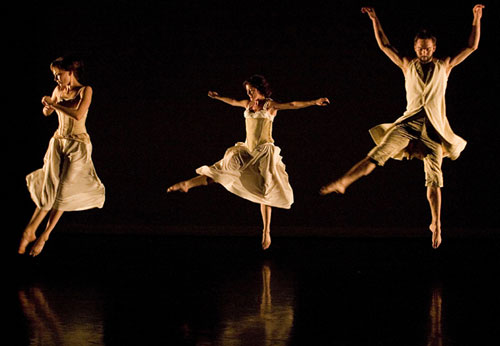
New York Baroque Dance Company in Seth Williams's Point of Departure. Photo by Chris Woltmann.
First it happened in the world of cookery--fusion cuisine replaced the more single-minded foreign cuisine as the next new thing. And before we knew it, the impulse migrated to the dance world with the same prevalence and fervor.
Classical ballet, of course, has for a couple of centuries been picking up "outsider" ways of moving--folk dance, jazz--and infusing its straight-laced principles with them, much to its advantage, shifting and growing slowly and organically, the way spoken language does. More abruptly, modern dance and ballet, once sworn adversaries, made friends, and we acquired the term "crossover choreographer." To adapt themselves to the concert stage, which is hardly their native--or even a congenial--element, flamenco and the tango have co-opted elements like narrative. More recently, classical Indian dance has looked beyond its traditional borders to annex other genres of movement from our now globalized culture.
No surprise, then, that the New York Baroque Dance Company, led by Catherine Turocy, the esteemed and charming scholar-performer of the late seventeenth- and early eighteenth-century dance that prefigured ballet, should have masterminded a show called "Points of Departure." At Brooklyn's Mark Morris Dance Center in late September, her company--augmented by Austin McCormick's Company XIV, and, where live music was used, accompanied by James Richman's admirable Concert Royal--presented a handful of pieces that used the movement style and themes of Baroque dance as a springboard into contemporaneity. Being a longtime admirer of Turocy's customary efforts, I wish I had loved them more.
The most ambitious item on the program, Seth Williams's Point of Departure proved to be the best of the offerings by a long shot. Why? Because it looks like a dance, not a self-conscious contrivance. Pointedly, its six performers wear handsome white and tan outfits that let them move freely, all the while subtly referencing period costume. In the first part of the piece, full of vivacity and bounce, the choreography makes you think of Baroque dance loosened up. Then, especially in its patterns and implied emotions, it begins to look like modern dance inspired (perhaps rather too literally) by Paul Taylor. The live music enhanced the proceedings immensely and the piece took on a let-joy-be-unconfined air. The standout among the dancers was Laura Careless, dulcet, buoyant, tender, and blessed with curly strawberry blonde hair.
Another group piece, Austin McCormick's Trompe L'Oeil provided a highfalutin program note about juxtaposing "the meditative/spiritual side...and the grotesquely distorted side of the Baroque." What we actually saw was a half-dozen barefoot dancers in fragments of Baroque costume and gilded face-paint, with golden masks worn on the back of their heads. In murky light, the players murkily enacted a tale of unstained romance menaced by the devil that lurks in us all. Davon Rainey, as the threatening yet irresistible persona, was the most compelling dancer of the lot.
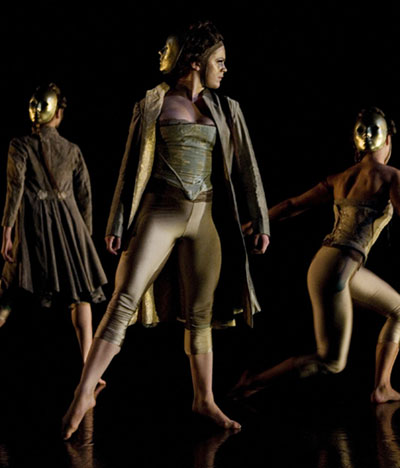
New York Baroque Dance Company in Austin McCormick's Trompe L'Oeil. Photo by Chris Woltmann.
Two women from NYBDC performed long (far too long) solos of their own creation; both dancers have much to learn about choreography. The innately dramatic Sarah Edgar offered Armida Abbandonata, though, without access to the press release, you'd have been unlikely to know that it referred specifically to "the unrequited love suffered by [a] ravishing Persian sorceress, queen and warrior." Trying to figure out what the hell is going on naturally distracts one's attention from the dancing itself, which was pretty, anguished, and finally vehement.
My favorite moment had Edgar scooping up the paper flowers she'd initially laid out to define the space she would use, lifting her arms over her head, and letting the crushed petals rain down on her body. Affecting too was the subsequent passage in which she crouched over her heart and belly in sorrow that translated into physical agony, then suddenly stood erect to move ferociously, embarking on a grief-fuelled revenge. I think this piece is salvageable and recommend Doris Humphrey's still-useful advice: "Cut it in half and fix the rest."
Patricia Beaman's Accumulating Venus was little more than a bagatelle--done gravely, alas, rather than lightly--about costume, the main feature of which was a length of vibrant persimmon curlicues suggesting the unruly fleece of a mythological animal given to erotic misbehavior. The piece consisted largely of a reverse strip-tease in which the dancer gradually donned the underpinnings of the female Baroque wardrobe, including the corset that confines--nearly immobilizes--the torso and the wire construction that enlarges the hips to Earth Mother proportions. The most vivid moment had the "fleece" shift from the role of cloak to that of a blanket of flowers covering the supine dancer as if she lay in her coffin.
Beaman incorporated the arm and hand behavior of Baroque dancing into her choreography, such as it was, and riffed weirdly on the period footwork, but these references looked obligatory and perfunctory. The marvelous costume was designed by Leslie Weinberg and constructed by Christian Milk.
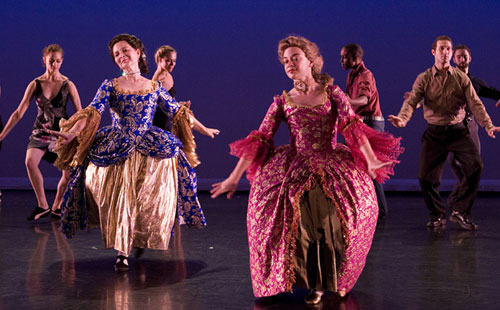
New York Baroque Dance Company in Catherine Turocy's Prelude. Photo by Chris Woltmann.
The program was framed by a pair of Turocy efforts to make the event cohere. Prelude featured a pair of female dancers in the ornate pannier-skirted gowns of the Baroque--all jewel tones and gilt--demonstrating the sedate carriage of the form (with its core of seductive mischief), its gently undulating arms decorated with filigreed work from wrist to fingertips, and its precise, frisky footwork. Caprice closed the show with all the evening's dancers outfitted for modern night life, in a structured improvisation. Just as in Baroque practice, where caprice meant improv and its demands were intended to cultivate and display the individuality of a performing artist, this piece, though slight and ramshackle, gave each participant a chance to shine. Turocy herself, with her gift for making rhythm visible, and Seth Williams, borrowing some spiffy moves from break dancing, provided the most delight.
© VoiceofDance.com 2007
This article originally appeared in Voice of Dance (http://www.voiceofdance.org) on September 21, 2007.
Big Dance Theater / Dance Theater Workshop, NYC / September 19-22, 25-29, 2007
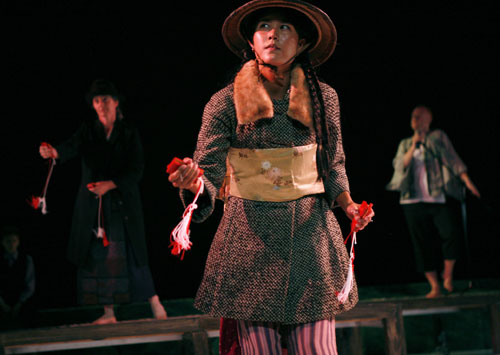
Big Dance Theater's The Other Here. Photo by Julieta Cervantes.
Here's the recipe for Big Dance Theater's The Other Here, just arrived at Dance Theater Workshop after a February premiere at Japan Society and a tour including Jacob's Pillow. I don't think the auteurs of this dance-theater group, Annie-B Parson and Paul Lazar, will object to my going public with it, because it operates on eternal human ground. The piece looks like the "pretend" games of vividly imaginative pre-literate children, in which the youngsters dress themselves in a motley assortment of co-opted clothing and fervidly enact, in words and motion, free-form stories that change as easily as weather though their theme holds strong at the center.
These are The Other Here's specific ingredients: Two texts: a pair of stories, The Carp and Life at Mr. Tange's by the celebrated Japanese writer Masubi Ibusi (1898-1993), who absorbed much about mood and human nature from Chekhov, and teaching materials published by American life-insurance purveyors happened upon in a used-book store by the troupe's dramaturg. Westerners' reverent but unavoidably skewed appreciation of traditional Japanese customs. Okinawan dance, reimagined by Parson, who comes from an American postmodern culture and accepts that fact blithely. Music ranging from Okinawan café ballads of the 1920s, rendered with just the right degree of sentiment by the impossibly pretty Heather Christian, and a deafening dose of latter-day pop. Gender fluidity, as in the diminutive Jess Barbagallo's dangerously persuasive insurance broker. (Though she looks like Tom Sawyer, Barbagallo is the most seductive performer in the piece.)
And then there's the fish. It's a valuable white carp given by a dying friend to the protagonist, one Mehdi (played by Lazar, who doubles as an insurance salesman losing his grip as he ages). Mehdi reluctantly promises to be responsible for the creature's fate and immediately, then over years, tries to find it another home. The carp, first shown in a Japanese wooden carrier-bucket, is, through Peter Flaherty's video magic, transferred to a large pond and then a huge one, growing each time--like a problem one has never fully addressed.
Needless to say, Big Dance Theater's most significant gift is for making disparate elements cohere in a realm beyond logic.
The atmosphere of the piece is nostalgic, regretful for promises unfulfilled, with pockets of gaiety (such as a bubbling clapping dance). It's infiltrated by the glib lies of the life-insurance folks, which serve as a metaphor for the dangerous untruths we tell, hear, and swallow every day. At the same time, it points to a co-existent world, one that's simpler, more honest and tolerant, in which pleasure and goodwill can flourish.
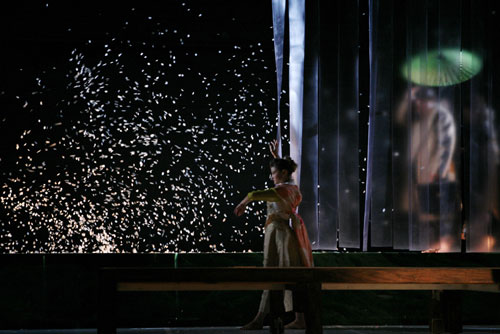
Big Dance Theater's The Other Here. Photo by Julieta Cervantes.
Other spare special effects are marvels, too, especially the use of a stage-wide panel of colorless translucent strips that form an upstage sky-to-earth curtain. Designed by Takeshi Kata, it blurs the image of people moving on a platform behind it--like a couple sheltering under a parasol--to create images that quietly evoke the prints of old Japan.
The piece serves as a lovely hour of entertainment--not forcefully or even significantly theatrical, but with an ability to send out ripples like a stone lightly skimmed on the surface of a lake or, if you will, a carp suddenly shifting direction in its watery domain. It is inordinately helped by the fact that its six performers--Barbagallo, Christian, Chris Giarmo, Molly Hickok, Lazar, and Jennie MaryTai Liu--are adorable, each in a different way.
The Other Here is crammed with enigmatic one-liners--amusing, profound, or both at once. "The truth of this life lies in its impermanence." "There is so much magic in what we do." As I understand it, some of the "pearls" come from the Ibusi stories, some from the insurance hawkers. More often than not, it's hard to tell which. Now there's irony for you.
© VoiceofDance.com 2007
This article originally appeared in the Culture section of Bloomberg News on Sept. 17, 2007.
Sept. 17 (Bloomberg) -- On film, swathed head to ankles in a tube of stretch jersey, the only bare flesh a face like an ancient mask and work-toughened hands and feet, Martha Graham dances ``Lamentation,'' her landmark 1930 solo that is the ultimate incarnation of grief.
``Lamentation Variations'' was concocted for the opening performance (significantly, on Sept. 11) of the Martha Graham Dance Company's two-week New York season. It follows the Graham footage with brief, slight pieces by Aszure Barton, Larry Keigwin and Richard Move (the Graham impersonator who used to be persona non grata with the troupe). These afterthoughts, borrowing some of Graham's gestures and fragments of the work's mood, are both insignificant and unnecessary.
Now under the direction of Janet Eilber, once a glamorous Graham principal, the company has been heir to chronic waves of disaster and dissolution in its 80-year life. Again, it's attempting rebirth (one of the legendary choreographer's favorite words). It's got three strikes against it.
The company has not yet produced heroic performers equal to those who brought Graham's great middle-period works to life in the 1930s and '40s -- pieces such as the flawless ``Appalachian Spring,'' the ecstatic ``Diversion of Angels'' and the tempestuous ``Night Journey'' and ``Cave of the Heart,'' all of which are being performed this season. Graham stars -- Pearl Lang, Mary Hinkson, Helen McGehee, Ethel Winter, Yuriko (Kikuchi), Matt Turney and Bertram Ross, among the ones I saw -- could tear a passion to tatters both physically and emotionally.
Operatic Scale
Then there's the cultural dissonance. Apart from Graham devotees, current audiences find even the best works hopelessly outdated, often ridiculous. The dances' fierce, gut-sprung vocabulary (Graham's unique invention) and their grand-opera emotive style couldn't be more contrary to the cool, sleek temper of the times.
And now Eilber, who can give the company no future if it can't sell tickets, has taken to ``contextualizing'' (one of her own favorite words) the repertory, promoting works of genius that used to speak perfectly well for themselves. Eilber has a different dance-world celebrity hosting each program, telling the audience what it's going to see and testifying to its worth.
Of course, there were redeeming moments. Relieving an alarmingly tepid opening night, the dancers playing the Adam- Eve-Lilith-Serpentine Stranger quartet in ``Embattled Garden'' unfroze a few minutes into the dance and went for broke. They still weren't wonderful, but they suddenly took a chance on owning their roles instead of working by rote like dutiful schoolchildren.
Vehement Eve
Cast against type to play Eve, Jennifer DePalo, a strong- boned woman with vehemence and concentration to match, was the most vivid of them. She proved her mettle the next night as the chief soloist in ``Sketches From `Chronicle,''' one of the few Graham pieces that regularly elicit cheers from today's viewers, with its superb, severe architecture and an all-female cast as self-contained as nuns and as ferocious as furies.
On the same program, DePalo also played the Leader of the Chorus, a secondary role in ``Night Journey,'' with concentrated fervor, putting a barely passable Jocasta and Oedipus in the shade.
I also liked the work of the young Atsuko Tonohata, as effervescent as spring in ``Diversion of Angels,'' and the veteran Miki Orihara, who seems to understand what's going on in a dance with every cell in her delicate body.
The third evening, as Medea in ``Cave of the Heart,'' Orihara approached that transcendent state in which the carefully designed choreography seemed to emanate from her own anatomy and state of mind. Tadej Brdnik, as Jason, used his blunt force effectively, in contrast to the other leading men in the troupe, who count too much on the beauty of their gorgeously honed physiques.
Most everything else I saw was destined to disappoint the old Graham fans and discourage new viewers.
Through Sept. 23 at the Joyce Theater, Eighth Ave. at 19th St. Information: +1-212-242-0800; http://www.joyce.org.
© 2007 Bloomberg L.P. All rights reserved. Reprinted with permission.
People ask where your passion for something started. As if a passion were an unreasonable thing to have and needed to be justified by a specific root cause.
For me, the devotion to dance began when I was a child and saw a picture in Life magazine. It was a small black and white photograph of Diana Adams in arabesque, as I later learned to call it, in George Balanchine's compact version of the sublime "white" acts of Swan Lake. As far as I was concerned, the image was a bolt from Heaven. I brought the magazine into the kitchen where my mother was producing one of the endless meals a middle-class housewife provided back in the day. "What's this?" I asked. My mother glanced away from the stove. "That's ballet," she replied, matter-of-factly, and turned her attention back to her casserole. "What's ballet?" I asked. I can't remember her reply, but I do recall understanding, on the instant, that ballet was for me. Talk about the fairy's kiss!
As for my devotion to the visual arts--as painting and the like are called, but, oddly, dance is not--that came even earlier, in our neighborhood branch of Woolworth's, the five-and-ten-cent store of my youth, a vast emporium crammed with small irresistible treasures (or so it seemed to a pigtailed eight-year-old).
I grew up in a time and a community where a mother could let her young offspring out of her sight for a moment without endangering the child's life. So while my mother, list in hand, ranged from counter to counter acquiring household and personal necessities--a frying pan, an inexpensive lipstick, a retractable measuring tape that, at a touch, would retreat into its hard shell like a startled snail--I could disappear in the direction of the Sewing Department (on the right, in back).
There, riveted to the spot, eyes wide, mouth slack with wonder, I would gaze at row upon row of inch-high wooden spools of 100% cotton sewing thread in every color imaginable, rising from waist height to far over my head. The thread had no pretensions to being silk--Woolworth's customers were common folk--yet it was wound on the spools so tightly and evenly that each spool gleamed like a unique beacon of colored light.
The spools were arranged according to hue, one hue succeeding the next in rainbow order, with pedestrian black and white relegated to the bottom row, like a grudging afterthought. Each color family--this was the marvel--offered infinite variations on its basic theme. Women brought minuscule swatches of fabric from which they planned to create a dress and matched thread to them exactly. Not sort of, not close enough to make no never mind, but exactly.
I had no desire to sew anything, a stubborn lack of interest that has lasted a lifetime. All I cared about was the phenomenal range of color: A dozen shades of pink lined up in order of color saturation from the faintest blush to an almost psychedelic strawberry. A riot of reds, now veering toward a stinging orange, now to succumbing to cinnabar; now surreptitiously creeping up on purple. Cool greens from palest seafoam to the forest darkness that approaches black but obdurately refuses to arrive at it. Blues beginning with the merest hint of blueness and methodically progressing through cerulean and sapphire to the velvety indigo of a midnight sky. Grays more subtly differentiated than any panoply of twilight shadows I'd seen. Even the beiges, so often dullards, were worth looking at.
When my mother finished her shopping and was ready to reclaim me, she'd purse her lips and give the family whistle to summon me to her side. Half the time I was so absorbed in the bewitching reels of color, I didn't hear her and she'd come looking for me. Soon she knew just where to find me. And one day she said, "If you like the thread so much, pick your favorite, and I will buy it for you."
"You don't understand," I cried to myself. "It's not one I like. It's all of them together. And I don't really want to have them. I just want to look at them." But as a child I never learned to say important things like this aloud. I whispered, head down, eyes on the floor, "No, it's all right." But, as with Diana Adams in the swan's arabesque, that glorious, hardly believable image of the spools of thread stayed with me, shaping me as I grew. I think I will die remembering it.
© 2007 Tobi Tobias
Sitelines
AJ Ads
 360° Dance Company at DTW offers two socially relevant revivals, Jane Dudley’s solo “Time Is Money” (1932) and Mary Anthony’s “Devil in Massachusetts” (1952) as well as the World Premier of Artistic Director, Martin Lofsnes' "6-1".
360° Dance Company at DTW offers two socially relevant revivals, Jane Dudley’s solo “Time Is Money” (1932) and Mary Anthony’s “Devil in Massachusetts” (1952) as well as the World Premier of Artistic Director, Martin Lofsnes' "6-1".
AJ Blogs
AJBlogCentral | rssculture
Terry Teachout on the arts in New York City
Andrew Taylor on the business of arts & culture
rock culture approximately
Laura Collins-Hughes on arts, culture and coverage
Richard Kessler on arts education
Douglas McLennan's blog
Dalouge Smith advocates for the Arts
Art from the American Outback
Chloe Veltman on how culture will save the world
For immediate release: the arts are marketable
No genre is the new genre
David Jays on theatre and dance
Paul Levy measures the Angles
Judith H. Dobrzynski on Culture
John Rockwell on the arts
innovations and impediments in not-for-profit arts
Jan Herman - arts, media & culture with 'tude
dance
Apollinaire Scherr talks about dance
Tobi Tobias on dance et al...
jazz
Howard Mandel's freelance Urban Improvisation
Focus on New Orleans. Jazz and Other Sounds
Doug Ramsey on Jazz and other matters...
media
Jeff Weinstein's Cultural Mixology
Martha Bayles on Film...
classical music
Fresh ideas on building arts communities
Greg Sandow performs a book-in-progress
Harvey Sachs on music, and various digressions
Bruce Brubaker on all things Piano
Kyle Gann on music after the fact
Greg Sandow on the future of Classical Music
Norman Lebrecht on Shifting Sound Worlds
Joe Horowitz on music
publishing
Jerome Weeks on Books
Scott McLemee on books, ideas & trash-culture ephemera
theatre
Wendy Rosenfield: covering drama, onstage and off
visual
Public Art, Public Space
Regina Hackett takes her Art To Go
John Perreault's art diary
Lee Rosenbaum's Cultural Commentary
